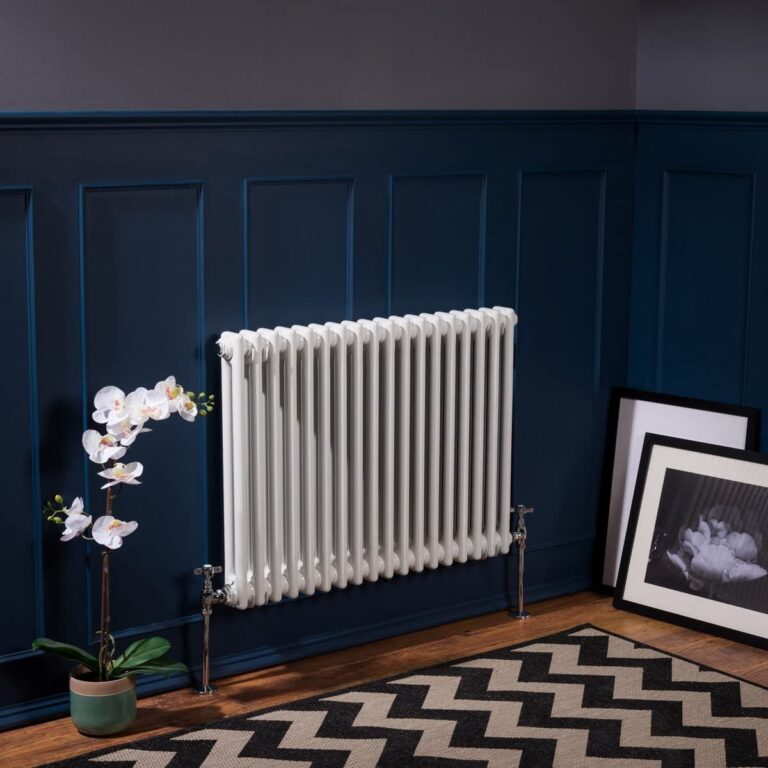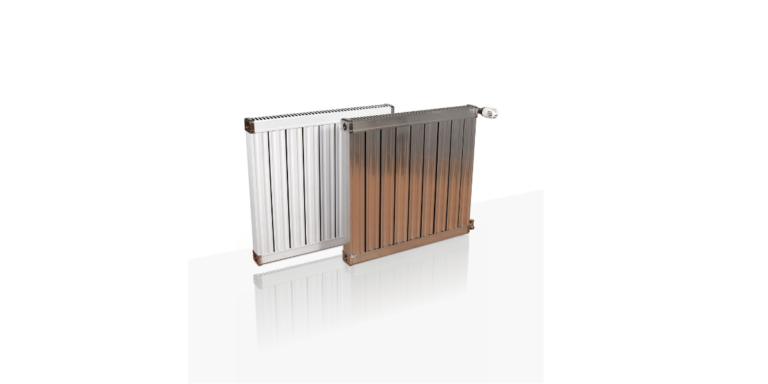Radiator valves are essential components of any central heating system – they allow us to control the flow of hot water through each radiator, so keeping them in good working condition is important to improve the overall efficiency of your radiators and heating system.
Many online guides explore how to change a radiator valve whilst also draining the heating system. However, this isn’t ideal as you’ll likely have to replace the inhibitor in your system. In this guide, we’ll show you how to replace the valve without draining the radiator or central heating system – making it a much quicker and more economical task!
If you’re unsure how to change a radiator valve – or if you’re wondering what can go wrong, this is the blog post for you – we’ll cover the exact steps you’ll need to take, whilst considering the common problems you might find with radiator valves.
So whether you’re replacing a broken valve or just looking to upgrade a manual valve to a thermostatic radiator valve for improved radiator efficiency (TRV), read on for instructions on how to get the job done quickly and easily.
How easy is it?
The process of changing a radiator valve is relatively easy but the steps vary slightly based on the type of heating system you have installed in your home. For example, you will only need to bung the expansion vent pipe and cold water feed within the header tank if you have a gravity-fed system – A pressurised system is more straightforward and doesn’t require this additional step.
How long does it take?
Replacing a radiator valve shouldn’t take too long if done properly. Typically, you can change a radiator valve within 30 minutes or so, depending on what type of boiler you have installed in your home (as mentioned above). Experienced DIYers may be able to complete this task more quickly than those who are less experienced or don’t have easy access (under kitchen cabinets etc). Additionally, if you follow our steps which don’t involve draining the system, then this can be an even quicker task.
Steps to install a new radiator valve without draining the system:
- Turn The Boiler Off
- Bleed The Radiator To Release The Pressure In The System
- Close The Lockshield Valve Inlet
- Prepare The Replacement Valve & Surrounding Area
- Loosen The Bottom Nut
- Loosen The Side Nut
- Remove the Old Radiator Valve
- Install The New Valve
Tools you’ll need:
Step 1: Turn The Boiler Off
The first step to changing a radiator valve is turning off your boiler at the fused spur switch on the wall. This will ensure that the boiler doesn’t engage and push more water through the system whilst you’re working on it, which would lead to quite a considerable leak!
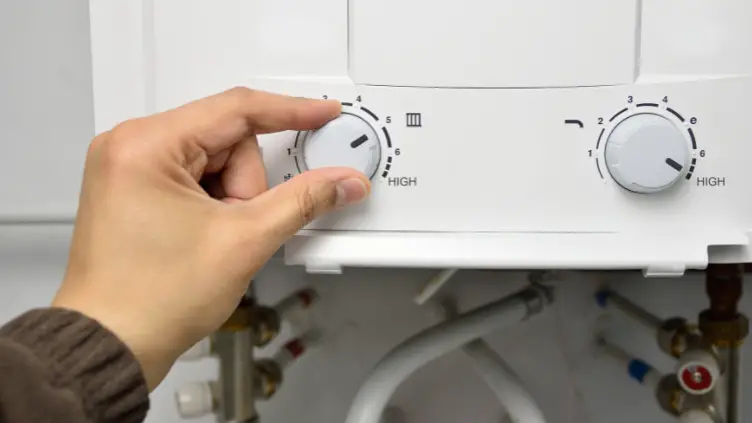
Step 2: Bleed The Radiator To Release The Pressure In The System
Use either a bleed valve key or a screwdriver to bleed the radiator – simply twist the valve anti-clockwise a quarter turn or until you start hearing a hissing sound, this means that the pressure is being released from the radiator. This will ensure that the pressure in the system is low enough for us to replace the valve.
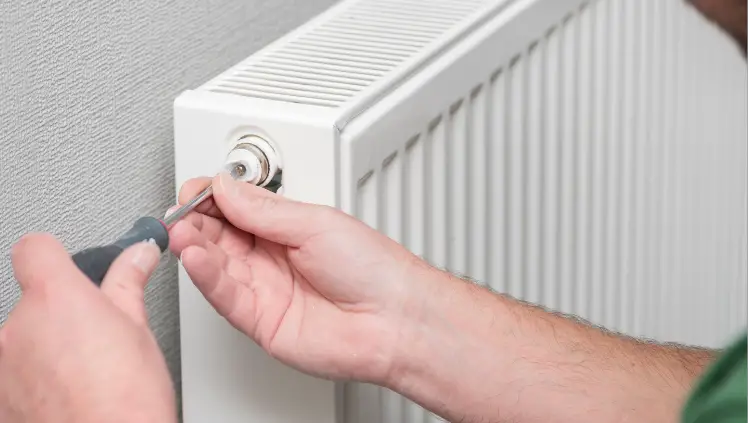
Don’t be too concerned if you see water escaping from the unit, this is normal so just ensure you have a towel or container ready to catch the drips. You’ll want to keep the valve open until the flow has reduced to a very small, light trickle. This means that the pressure in the system is low enough for us to remove the valve.
Step 3: Close The Lockshield Valve Inlet
Remove the cap from the top of the lockshield to expose the pin (this will be on the opposite side of the radiator from the one you are replacing). Simply use your wrench or adjustable spanner to turn the pin clockwise – this will ensure that the radiator is turned off there is no more water entering into the radiator whilst we remove the valve from the opposite end of the radiator.
Step 4: Prepare The Replacement Valve & Surrounding Area
Now that we’re ready to remove the old valve and replace it with an updated, newer TRV valve, we want to ensure that the area is prepped for any spillages or leakage. There will likely be some water that comes out of the radiator so make sure you’ve got your towels and container to hand!
To prep your new radiator valve, simply remove the nut and olive from the unit – we already have these in place on the existing setup so there’s no need to use these. Just take a minute to visualize the orientation of the valve so that the thermostat is facing the right direction before committing to fitting the valve. The connections should simply match your existing valve orientation and position.
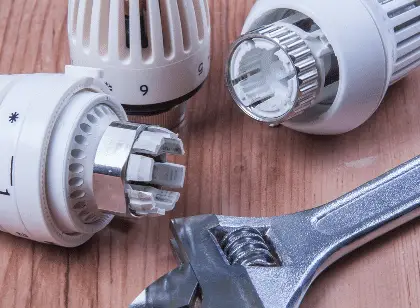
Finally, ensure that the new valve is shut (it should be turned fully clockwise). This means when we’re attaching it there’s no way for the water to run through the valve – making it even easier to control any leakage that does run out whilst making the replacement.
Step 5: Loosen The Bottom Nut
Now we’ll need to loosen the bottom nut underneath the old valve, start slow with a small 1/4 or 1/2 twist – just enough until you feel the friction release. You may notice a few drips so just wipe them away with your towel.
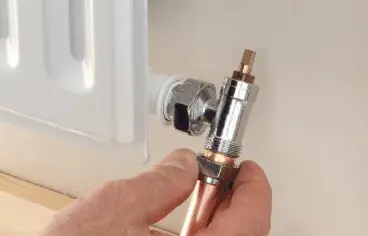
Step 6: Loosen The Side Nut
Carefully loosen the nut that attaches the valve to the radiator itself. It’s very important to secure the valve itself whilst making this adjustment. If you try to force the nut loose without supporting the valve it is possible that the copper piping may become misshapen or bent. A gripper tool works well here – simply twist the nut with one hand whilst holding the valve in position with your other hand.
Once the nut has been loosened with your spanner or wrench, you can usually use your fingers to finish off the rest of the way. Don’t be alarmed if more water begins to flow out – this is normal. You may need to work quickly though to reduce the amount of water lost from the system.
Step 7: Remove the Old Radiator Valve
Now we need to remove the old valve by gently pushing it free, there should be some flexibility in the copper or plastic piping but don’t create any kinks or bends. Be gentle, using a small amount of force to wiggle the valve free.
Step 8: Install The New Valve
Attaching a new radiator valve is relatively simple – all you need to do is place the TRV back in place of the old valve and start twisting the nuts back onto the threads. Start with the one connecting to the radiator for the smallest amount of water loss. Remember, the new valve should be in a closed position so that once the side nut is fitted the water should dripping into the container.

Again, it’s advised to use grippers whilst tightening the nuts to ensure that no kinks or bends are made on the copper piping. Hold the valve in a fixed position whilst twisting the nuts with your other hand.
Conclusion
Congratulations… you’ve just changed your own radiator valve from start to finish without breaking a sweat -and you did it yourself! If done correctly, changing your radiator valves should only take about 30 minutes at the most.
However, if at any point during this process something doesn’t seem right, make sure to call an experienced professional for help rather than attempting further DIY fixes, as these may end up making matters worse instead of better. Also, if you are frustrated that your radiators are no longer heating up as they should, it might be time to replace your radiator and upgrade it to a newer model.
Thanks for reading – we hope this guide was helpful for any future projects involving changing a radiator valve in your home.
FAQ’s
Can You Replace A Radiator Valve By Yourself?
Anyone can replace a radiator valve by themselves – all it takes is a little research and 30 minutes of your attention. It’s something that any DIY-enthusiast can do but if you’re struggling then you can always speak to a plumber for some help.
What Causes A Faulty Radiator Valve?
The most common cause of radiator valve failure is corrosion due to leaky seals or faulty valves. In some cases, malfunctioning radiator valves can cause the radiators themselves to become noisy or even leaky. You may also notice that your radiators aren’t getting as hot as they used to, which could be caused by a faulty valve that needs to be opened more for hot water to flow through it.
How Often Should You Replace Your Radiator Valves?
It’s difficult to provide an exact timeframe for when you should replace your radiator valves because every home is different, and radiators often vary in age and condition. However, as a general rule of thumb, it’s recommended that you check your radiator valves annually and replace them if necessary. This will help ensure that they are functioning properly and that your heating system is running efficiently.
Can You Change The Radiator Valves Without Draining The System?
Yes! It is absolutely possible to change your radiator valves without draining the system. This involves isolating the radiator from the rest of the central heating system and bleeding the individual radiator before replacing the TRV valve. Simply refer to our full guide for more details.



